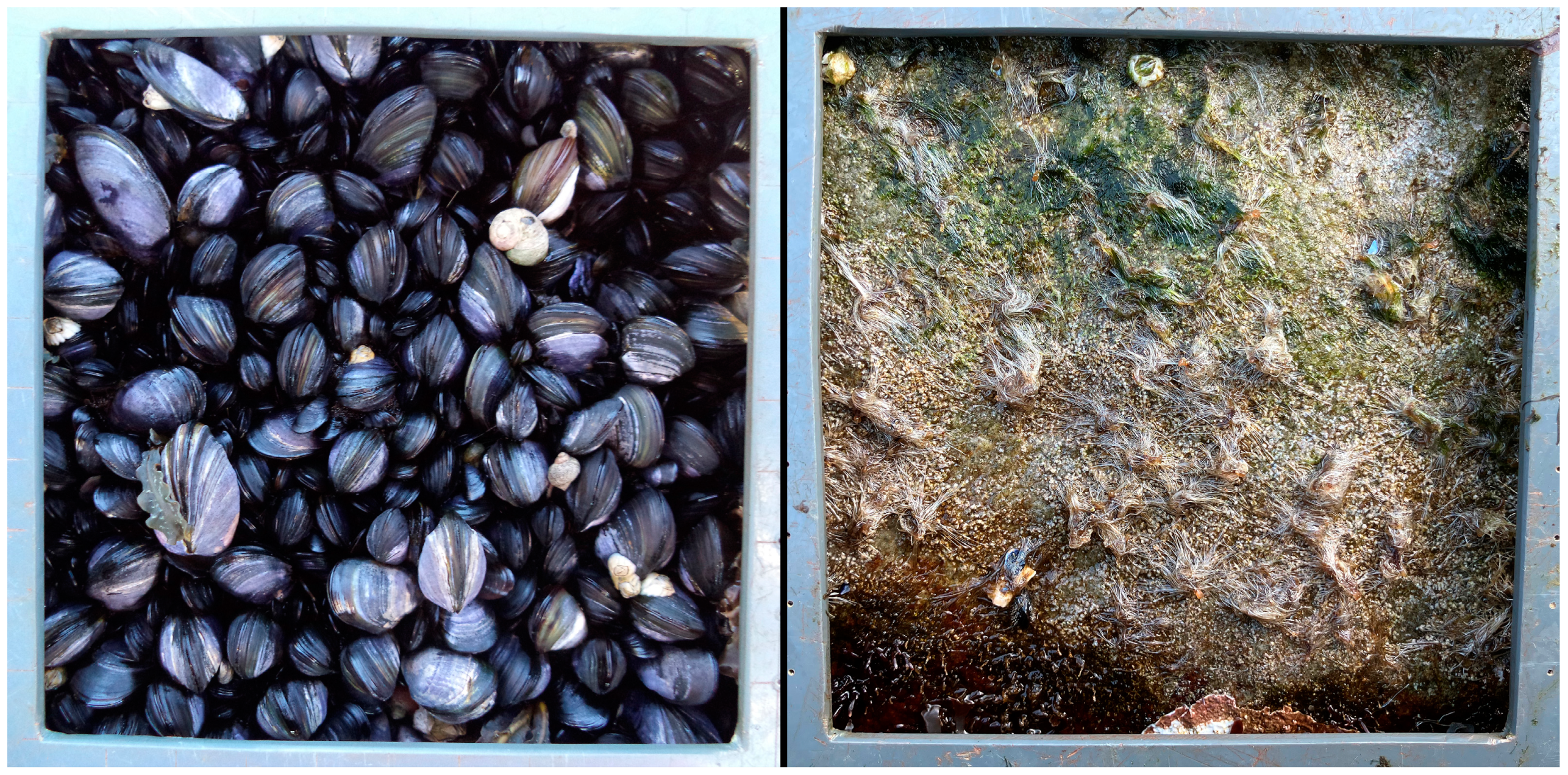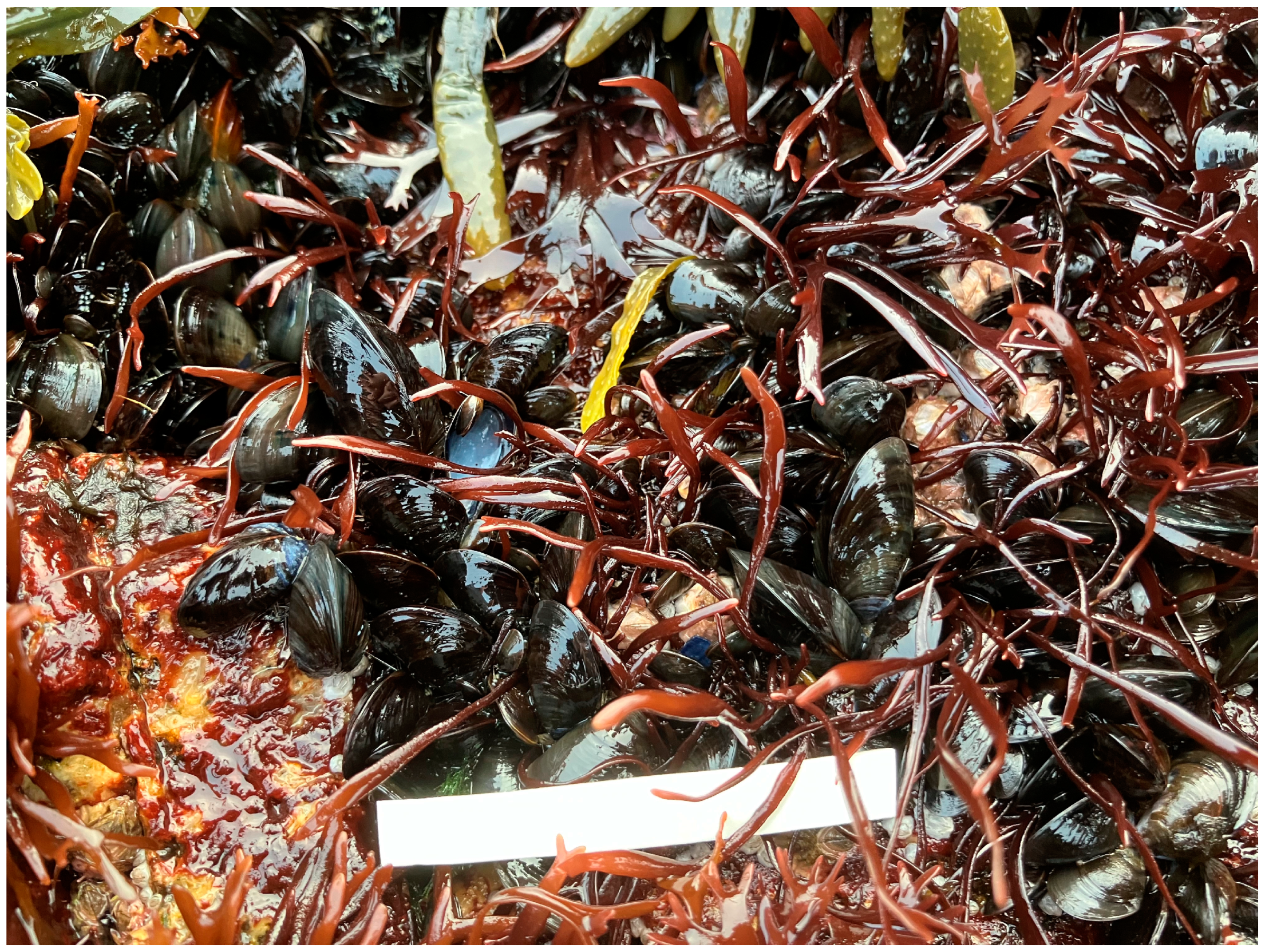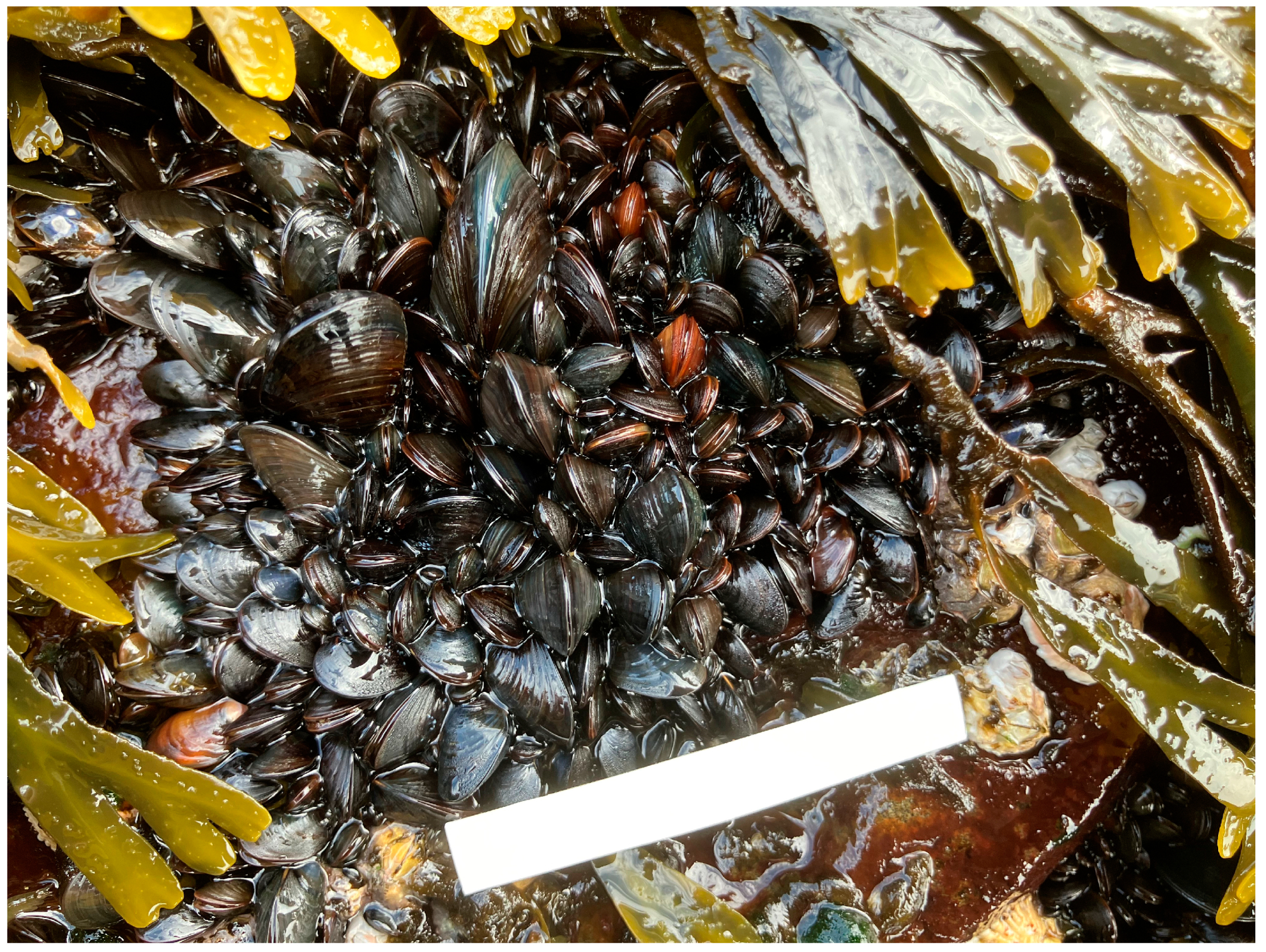Recolonization of Intertidal Mussels in Nova Scotia (Canada) after Their Mass Disappearance Following the Severe 2023 Winter Cold Snap
Abstract
Author Contributions
Funding
Conflicts of Interest
References
- Cameron, N.M.; Scrosati, R.A. Mass disappearance of intertidal mussels after an unusual winter cold snap in eastern Canada. Ecology 2023, 104, e4179. [Google Scholar] [CrossRef] [PubMed]
- You, Q.; Cai, Z.; Pepin, N.; Chen, D.; Ahrens, B.; Jiang, Z.; Wu, F.; Kang, S.; Zhang, R.; Wu, T.; et al. Warming amplification over the Arctic Pole and Third Pole: Trends, mechanisms, and consequences. Earth Sci. Rev. 2021, 17, 103625. [Google Scholar] [CrossRef]
- Armstrong, L. Growers Say It’ll Be Years before N.S. Vineyards Recover from ‘Devastating’ Cold Snap. Available online: https://www.thestar.com/news/canada/2023/02/10/recent-extreme-cold-snap-causes-devastating-damage-to-nova-scotia-vineyards.html (accessed on 12 August 2024).
- The Canadian Press. Eastern Canada Cold Snap Ends, but Thousands in N.S. and N.B. Still without Power. Available online: https://www.thestar.com/news/canada/2023/02/05/eastern-canada-cold-snap-ends-but-thousands-in-ns-and-nb-still-without-power.html (accessed on 30 July 2024).
- Scrosati, R.A.; Cameron, N.M. Mass bleaching in intertidal canopy-forming seaweeds after unusually low winter air temperatures in Atlantic Canada. Diversity 2023, 15, 750. [Google Scholar] [CrossRef]
- Scrosati, R.A.; Freeman, M.J.; Ellrich, J.A.; Petzold, W. Biogeography of algae and invertebrates from wave-exposed rocky intertidal habitats along the Atlantic coast of Nova Scotia (Canada): Latitudinal and interannual patterns and possible underlying drivers. Front. Mar. Sci. 2022, 9, 987162. [Google Scholar] [CrossRef]
- Arribas, L.P.; Donnarumma, L.; Palomo, M.G.; Scrosati, R.A. Intertidal mussels as ecosystem engineers: Their associated invertebrate biodiversity under contrasting wave exposures. Mar. Biodivers. 2014, 44, 203–211. [Google Scholar] [CrossRef]
- Cameron, N.M.; Scrosati, R.A.; Valdivia, N. Structural and functional properties of foundation species (mussels vs. seaweeds) predict functional aspects of the associated communities. Community Ecol. 2024, 25, 65–74. [Google Scholar] [CrossRef]
- Cameron, N.M.; Scrosati, R.A.; Valdivia, N.; Meunier, Z.D. Global taxonomic and functional patterns in invertebrate assemblages from rocky-intertidal mussel beds. Sci. Rep. 2024, 14, 26. [Google Scholar] [CrossRef] [PubMed]
- Fields, J.B.; Silbiger, N.J. Foundation species loss alters multiple ecosystem functions within temperate tidepool communities. Mar. Ecol. Prog. Ser. 2022, 683, 1–19. [Google Scholar] [CrossRef]
- Sorte, C.J.B.; Davidson, V.E.; Franklin, M.C.; Benes, K.M.; Doellman, M.M.; Etter, R.J.; Hannigan, R.E.; Lubchenco, J.; Menge, B.A. Long-term declines in an intertidal foundation species parallel shifts in community composition. Glob. Chang. Biol. 2017, 23, 341–352. [Google Scholar] [CrossRef] [PubMed]
- Wernberg, T.; Thomsen, M.S.; Baum, J.K.; Bishop, M.J.; Bruno, J.F.; Coleman, M.A.; Filbee-Dexter, K.; Gagnon, K.; He, Q.; Murdiyarso, D.; et al. Impacts of climate change on marine foundation species. Annu. Rev. Mar. Sci. 2024, 16, 247–282. [Google Scholar] [CrossRef] [PubMed]
- Mendez, M.M.; Livore, J.P.; Márquez, F.; Bigatti, G. Mass mortality of foundation species on rocky shores: Testing a methodology for a continental monitoring program. Front. Mar. Sci. 2021, 8, 620866. [Google Scholar] [CrossRef]
- Raymond, W.W.; Barber, J.S.; Dethier, M.N.; Hayford, H.A.; Harley, C.D.G.; King, T.L.; Paul, B.; Speck, C.A.; Tobin, E.D.; Raymond, A.E.T.; et al. Assessment of the impacts of an unprecedented heatwave on intertidal shellfish on the Salish Sea. Ecology 2022, 103, e3798. [Google Scholar] [CrossRef]
- Scrosati, R.A. Recovery of intertidal mussel stands three years after the severe 2021 heatwave in British Columbia, Canada. Diversity 2024, 16, 396. [Google Scholar] [CrossRef]
- Intergovernmental Panel on Climate Change. AR6 Synthesis Report: Climate Change. 2023. Available online: https://www.ipcc.ch/report/sixth-assessment-report-cycle (accessed on 12 August 2024).
- Edmunds, P.J. Decadal-scale time series highlight the role of chronic disturbances in driving ecosystem collapse in the Anthropocene. Ecology 2024, 105, e4360. [Google Scholar] [CrossRef] [PubMed]
- Emslie, M.J.; Logan, M.; Bray, P.; Ceccarelli, D.M.; Cheal, A.J.; Hughes, T.P.; Johns, K.A.; Jonker, M.J.; Kennedy, E.V.; Kerry, J.T.; et al. Increasing disturbance frequency undermines coral reef recovery. Ecol. Monogr. 2024, 94, e1619. [Google Scholar] [CrossRef]
- Menge, B.A.; Robinson, J.W.; Poirson, B.N.; Gravem, S.A. Quantitative biogeography: Decreasing and more variable dynamics of critical species in an iconic meta-ecosystem. Ecol. Monogr. 2023, 93, e1556. [Google Scholar] [CrossRef]
- Edmunds, P.J. Why keep monitoring coral reefs? BioScience 2024, 74, biae046. [Google Scholar] [CrossRef]




Disclaimer/Publisher’s Note: The statements, opinions and data contained in all publications are solely those of the individual author(s) and contributor(s) and not of MDPI and/or the editor(s). MDPI and/or the editor(s) disclaim responsibility for any injury to people or property resulting from any ideas, methods, instructions or products referred to in the content. |
© 2024 by the authors. Licensee MDPI, Basel, Switzerland. This article is an open access article distributed under the terms and conditions of the Creative Commons Attribution (CC BY) license (https://creativecommons.org/licenses/by/4.0/).
Share and Cite
Scrosati, R.A.; Cameron, N.M. Recolonization of Intertidal Mussels in Nova Scotia (Canada) after Their Mass Disappearance Following the Severe 2023 Winter Cold Snap. Diversity 2024, 16, 503. https://doi.org/10.3390/d16080503
Scrosati RA, Cameron NM. Recolonization of Intertidal Mussels in Nova Scotia (Canada) after Their Mass Disappearance Following the Severe 2023 Winter Cold Snap. Diversity. 2024; 16(8):503. https://doi.org/10.3390/d16080503
Chicago/Turabian StyleScrosati, Ricardo A., and Nicole M. Cameron. 2024. "Recolonization of Intertidal Mussels in Nova Scotia (Canada) after Their Mass Disappearance Following the Severe 2023 Winter Cold Snap" Diversity 16, no. 8: 503. https://doi.org/10.3390/d16080503
APA StyleScrosati, R. A., & Cameron, N. M. (2024). Recolonization of Intertidal Mussels in Nova Scotia (Canada) after Their Mass Disappearance Following the Severe 2023 Winter Cold Snap. Diversity, 16(8), 503. https://doi.org/10.3390/d16080503





